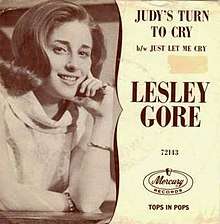Judy's Turn to Cry
"Judy's Turn to Cry" is a song written by Beverly Ross[1] and Edna Lewis that was originally released by Lesley Gore in 1963. The song was produced by Quincy Jones, who also produced Gore's prior hit "It's My Party".[2] It was released on Gore's first album I'll Cry If I Want To and also as a single which reached #5 on the Billboard Hot 100 chart and #10 on the Billboard R&B singles chart.[3][4] The single earned a gold record.[5]
| "Judy's Turn to Cry" | ||||
|---|---|---|---|---|
 | ||||
| Single by Lesley Gore | ||||
| from the album I'll Cry If I Want to | ||||
| B-side | "Just Let Me Cry" | |||
| Released | June 1963 | |||
| Recorded | May 14, 1963 | |||
| Genre | Pop, rock | |||
| Length | 2:12 | |||
| Label | Mercury Records | |||
| Songwriter(s) | Beverly Ross, Edna Lewis | |||
| Producer(s) | Quincy Jones | |||
| Lesley Gore singles chronology | ||||
| ||||
When "It's My Party" entered the Billboard Hot 100 on May 11, 1963, Gore's label, Mercury Records rushed to record a sequel.[6] The sequel, "Judy's Turn to Cry," was recorded on May 14, 1963.[6] In "It's My Party," the singer was in tears because her boyfriend Johnny left with her best friend Judy. In "Judy's Turn to Cry," the singer kisses another boy at another party in order to make Johnny jealous and Johnny hits the other boy and returns to her.[2][7][8][9] In the chorus, which also opens the song, the triumphant singer gloats that "Well now it's Judy's turn to cry, Judy's turn to cry, Judy's turn to cry; 'cause Johnny's come back to me."[10] Until then the singer's "tears just fell like rain drops" because "Judy's smile was so mean."[2] With its emphasis on crying—in this case Judy rather than the singer—the song fit in with the theme of the album I'll Cry If I Want To, in which most of the songs involved someone crying.[11]
The song's instrumentation includes drums and horns.[2] Allmusic critic Joe Viglione describes "Judy's Turn to Cry" as having "a monstrous hook as valuable as 'It's My Party' with violence that may have been inspired by The Crystals pushing the envelope with their withdrawn classic 'He Hit Me (It Felt Like a Kiss)'".[2] Viglione also notes that because both "It's My Party" and "Judy's Turn to Cry" are short, both at just under 2:20, and both songs are different from each other, and each starts off with its own identifiable hook, and the choruses are different but the verses tell one continuous story, the two songs could be played on the radio back to back, allowing Gore to sing the entire "soap opera."[2] This song is in the key of D Major, while "It's my Party" is in the key of A Major.[12] Connie Landers sang the two songs back to back on the 2008 album Girls Girls Girls: 1960's Rock N Roll.[13] Author Maury Dean notes that Gore's "crisp soprano uses very sophisticated jazz progressions."[7] Music journalist Lillian Roxon commented that "you could savor every bitchy second of Lesley's triumph with her sequel 'Judy's Turn to Cry.'"[14][15]
Subsequent to initial release as a single and on I'll Cry If I Want To, "Judy's Turn to Cry" has been released on numerous Lesley Gore compilation albums. These include The Golden Hits of Lesley Gore in 1965, It's My Party: The Mercury Anthology in 1996, Sunshine, Lollipops, and Rainbows: The Best of Lesley Gore in 1998, 20th Century Masters – The Millennium Collection in 2000 and The Ultimate Collection 1963–1968: Start the Party Again in 2005.[16] It has also been included on a number of multi-artist compilations of 1960s songs.[16]
Charts
| Chart (1963) | Peak position |
|---|---|
| US Billboard Hot 100 | 5 |
| US Hot R&B Sides | 10 |
References
- Larkin, C. (1998). The Virgin Encyclopedia of Fifties Music. Virgin. p. 315.
- Viglione, J. "Judy's Turn to Cry". Allmusic. Retrieved July 19, 2011.
- "Lesley Gore Charts and Awards". Allmusic. Retrieved July 19, 2011.
- Studwell, W.E.; Lonergan, D. (1999). The classic rock and roll reader: rock music from its beginnings to the mid-1970s. Psychology Press. p. 252. ISBN 978-0-7890-0151-1.
- Larkin, C. (1995). The Guinness encyclopedia of popular music, Volume 3 (2 ed.). University of California. p. 1705. ISBN 978-1-56159-176-3.
- Goldmine Magazine (1999). Goldmine roots of rock digest. Krause Publications. p. 183. ISBN 978-0-87341-775-4.
- Dean, M. (2003). Rock 'n' roll: Gold rush : a singles un-encyclopedia. Algora Publishing. p. 189. ISBN 978-0-87586-207-1.
- Ankeny, J. "It's My Party". Allmusic. Retrieved July 20, 2011.
- Sachs, T. (July 200). Liner notes-20th Century Masters – The Millennium Collection: The Best of Lesley Gore. Mercury Records. Check date values in:
|date=(help) - Taylor, T.L.; Crain, M.B. (1999). Angel Courage: 365 Meditations and Insights to Get Us Through Hard Times. HarperCollins. p. 2. ISBN 978-0-06-251583-4.
- Unterberger, R. "I'll Cry If I Want to". allmusic. Retrieved July 19, 2011.
- McClary, S., Knapp, R., Baur, S. & Warwick, J.C. (2008). Musicological identities: essays in honor of Susan McClary. Ashgate. p. 71. ISBN 978-0-7546-6302-7.CS1 maint: multiple names: authors list (link)
- "Girls Girls Girls: 1960's Rock N Roll". Allmusic. Retrieved July 19, 2011.
- Roxon, L. (1974). Rock Encyclopedia. University of Michigan. p. 207.
- Milliken, R. (2010). Mother of Rock: The Lillion Roxon Story (2 ed.). Black, Inc. p. 274. ISBN 978-1-4587-8017-1.
- "Judy's Turn to Cry". Allmusic. Retrieved July 19, 2011.